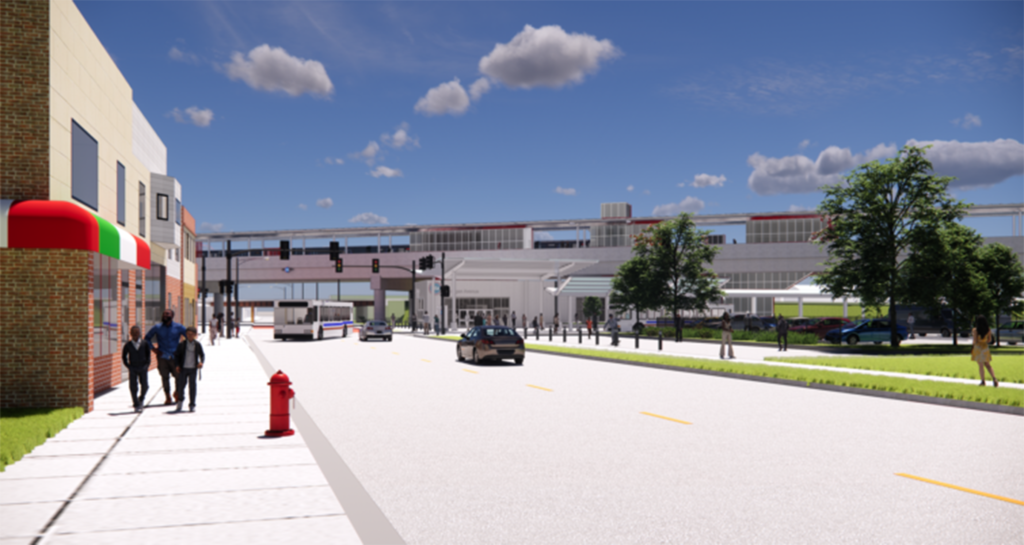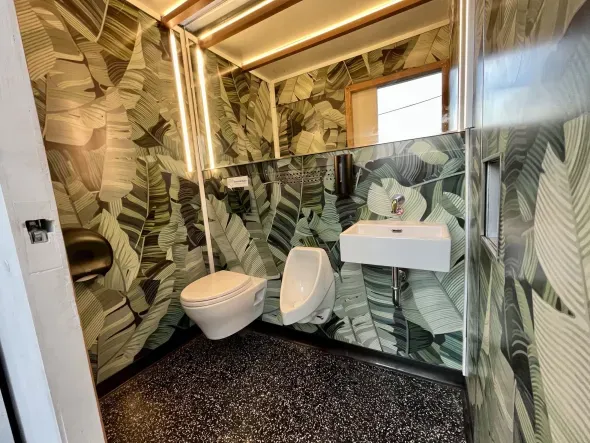The Metropolitan Atlanta Rapid Transit Authority (MARTA) awards a contract for a new automated fare collection system. Also, Chicago Transit Authority’s (CTA) Red Line Extension (RLE) project will receive a $100 million federal grant; LA Metro’s pilot program to test restrooms for riders and staff begins this month at four stations; the Washington Metropolitan Area Transit Authority (WMATA) commits to regular checks of brake bolts after derailment; and $900,000 in local emergency response funding will be released for additional safety equipment associated with the Massachusetts Bay Transportation Authority’s (MBTA) new South Coast Rail (SCR) service in 2024.
MARTA
MARTA’s Board of Directors on Oct. 12 awarded a contract for the installation of a new automated fare collection system (AFC 2.0) to Innovation in Transportation, Inc. (INIT).
According to the agency, MARTA, which has renewed its focus on “Service, Experience, and Expansion (SEE),” says its customers will quickly see how user-friendly the new fare system is, allowing multiple methods of payment, including debit and credit cards and mobile wallets directly at the fare gate without having to use a vending machine.
Eventually, AFC 2.0 will fully replace MARTA’s existing Breeze card and Breeze Mobile systems and will involve the replacement and upgrading of rail station fare gates and bus fareboxes throughout the system. The new automated fare system will be deployed over the next five years.
The new AFC 2.0 system will provide many benefits to MARTA and its customers, including:
A more convenient open payments system: Customers will be able to use their debit card, credit card or mobile wallet, as well as a Breeze card, to pay the fare. This will make the system more intuitive, shorten the fare payment process, and reduce wait times at ticket vending machines.
Upgraded faregates: The new faregates at each of MARTA’s 38 rail stations will be faster and more reliable.
More user-friendly ticket machines: Rail stations will also have new ticket vending machines that will be more dependable and will do things like provide exact change in bills rather than just coins.
Modernized bus fare boxes: MARTA’s buses will be outfitted with fare boxes with large digital screens and improved software that will speed up the boarding process.
An expandable system: The new system will bring in all transit modes, including bus, rail, MARTA Rapid, and the Atlanta Streetcar, which is currently on its own payment system. And regional transit partners can also be integrated quickly into the system.
A more adaptable system: The AFC 2.0 system is “open-architecture,” allowing a variety of software and apps, such as trip-planning apps, to connect to the MARTA system.
Improved ability to customize pricing: The system will allow MARTA to be nimble and flexible with pricing, whether it’s for employer programs, senior or student rider discounts, or for special events and promotions.
An expansive retail network: Cash customers will be able to load their Breeze cards at the checkout lines of as many as 240 retail locations. Currently, MARTA’s cash customers must first travel to a rail station or justice center to reload their Breeze cards.
“First and foremost, this new, state-of-the-art fare collection system will improve service and provide customers with a better overall experience,” said MARTA General Manager and CEO Collie Greenwood. “And from our side, AFC 2.0 will allow us to further optimize our operations and increase farebox recovery. It’s a major win for both MARTA and our riders.”
“This is an exciting day for MARTA,” said MARTA Board Chair Thomas Worthy. “We’re often asked when customers will be able to tap their debit or credit card at the fare gate, and they’ll be able to do so with this new system. We’ll also be better positioned to meet the needs of our customers well into the future.”
CTA
CTA announced on Oct. 12 that the RLE project, which will build a 5.6-mile extension of the Red Line to 130th Street, will receive another $100 million of federal funding, moving the project closer to the agency’s goal of breaking ground in 2025.
The project will receive a $100 million grant from the federal Congestion Mitigation and Air Quality Improvement (CMAQ)/Carbon Reduction Program, after receiving $30 million from the same source in 2021. The announcement follows the recent notification from the Federal Transit Administration (FTA) in September 2023 that the RLE project was in line to receive $1.973 billion of federal “New Starts” funding.
“CTA is successfully putting together the critical funding we need to build the transformational Red Line Extension, which will increase access to transit for Far South Side residents and serve as an economic catalyst for the region,” said CTA President Dorval R. Carter, Jr. “The Red Line Extension will improve residents’ quality of life by increasing access to jobs, education and more. I thank our federal partners for the continuing support of this life-changing project.”
The remaining project funding will come from a $950 million Transit TIF approved by Chicago City Council in 2022 and other sources.
 |
LA Metro
Beginning this month, LA Metro will launch a six-month pilot program that will add toilets at three busy stations for riders—Westlake/MacArthur Park on the B/D Lines, Willowbrook/Rosa Parks on the A/C Lines and Norwalk on the C Line. LA Metro will also add a non-public restroom at the Sylmar/San Fernando Metrolink Station for bus operator taking breaks.
These, LA Metro says, will join the public restrooms that the agency already has at Union Station, El Monte Station and Harbor Gateway.
 | |
| The interior of a Throne unit. |
LA Metro is partnering with start-up company Throne on the pilot program, which is made possible by the agency’s proposal process overseen by the Office of Strategic Innovation. Each Throne unit is portable, ADA accessible, touchless and includes a flush toilet, a sink with running water and robust ventilation system. The units run on solar power and require no connections to water, sewer or electricity; each unit has a freshwater and wastewater tank that is more than four times larger than what’s found in a regular portable toilet, according to Throne.
Here’s how it will work:
The toilets will be free and can be unlocked via QR code or by sending a quick SMS text message with a cell phone—a smartphone or flip phone will work (our most recent customer survey shows that 92% of riders have a basic cell phone or smartphone). Tying use to a phone number allows Throne to add accountability to public restrooms by warning or restricting access to users that break rules or damage the restrooms.
Toilets will generally be open 6 a.m. to 9 p.m. seven days a week. Exact hours may vary by location. All visual and audio instructions are provided in English and Spanish.
Each Throne unit is equipped with 21 internet-connected sensors that allow Throne to know if everything is working—and when units need cleaning. In addition, users will be asked to rate their restroom experience and let Throne know when there are issues that require attention.
Throne use is limited to 10 minutes, which is consistent with other automated restrooms such as the ones at El Monte and Harbor Gateway. Visitors are made aware of the time limit when entering the restroom and the door automatically opens after 10 minutes with ample warning to the user. The door will stay open until the user exits.
Metro Ambassadors will have the ability to open toilets if not in use and will be monitoring the toilets to help riders access them if needed.
“We expect to learn much from the pilot, specifically how the public toilets perform, the demand for them and public acceptance,” LA Metro. “The findings will help guide us when it comes to public restrooms in the future.”
WMATA
Following inspections of the derailment of a 7000-series train last month outside Reagan National Airport, which showed that about 6% of brake discs on WMATA’s older cars were problematic, the agency has adopted new protocols requiring a torque check of bolts on its older cars every 60 days to ensure they are properly tightened, according to a report by The Washington Post.
“This is well above and beyond the industry-recommended procedures and adds additional conservatism over our existing process,” said WMATA Chief Mechanical Officer Shushil Ramnaress during Thursday’s board meeting, according to The Washington Post report.
According to the report, WMATA and its regulator are “continuing to investigate both trains involved in the incident, including the derailed 7000-series train.”
“The train had 43 passengers onboard and remained upright when a lone car went off the track. The incident prompted a fresh investigation into WMATA’s rail cars at a time when transit officials are notching pandemic-era ridership records while facing a growing budget shortfall,” according to The Washington Post report.
According to the report, “the 7000-series train was southbound on Sept. 29 toward the Franconia-Springfield station when it hit a brake disc that had fallen off another train. The Blue Line train started weaving, and the first axle on the wheel assembly came off the track south of the airport station’s Metro platform.
“The brake had fallen from a 3000-series train that preceded the derailed train. The series, built in the late 1980s, is Metro’s second-oldest active rail-car model and is scheduled to be retired. The derailment prompted Metro to pull its 3000- and 2000-series cars from service Sept. 30 while initiating inspections on all 352 cars in those series.
“Of the 2,816 brake discs probed for loose bolts or other safety issues, 182 did not pass inspection. Each disc is held together with eight bolts connected by a safety wire that wraps around each bolt head as an additional measure to keep them in place.”
According to The Washington Post report, WMATA’s engineers are “analyzing data from inspections and maintenance records of the 3000-series train and 7000-series train to compile a report on the derailment, its cause and any ramifications.”
WMATA’s 7000-series cars, The Washington Post reports, “are the subject of a federal safety investigation after a 2021 derailment revealed a defect caused several cars’ wheels to push outward, creating instability. The series is Metro’s most advanced car and makes up nearly 60 percent of its fleet. The cars had been suspended but are being reincorporated into service with regular wheel screenings.”
According to the report, WMATA officials said “the wheel defect and the most recent derailment are not related. Inspections found no wheel alignment deviations among the system’s older cars.”
MBTA
Rep. Bill Straus (D-Mattapoisett) recently announced an agreement with Massachusetts Transportation Secretary Monica Tibbits-Nutt to release $900,000 in local emergency response funding for additional safety equipment associated with the MBTA’s new SCR service in 2024, according to a New Bedford Guide report.
According to the report, the agreement arose from a renewed request from the Representative during a meeting with the Secretary and MBTA General Manager Phil Eng on Oct. 11. This money, the New Bedford Guide reports, “originated as an amendment filed by the Representative with support of the South Coast delegation and was authorized in the 2022 Transportation Bond Bill.”
“The idea, however, for providing train related safety equipment directly to area Fire and EMS Departments belongs to New Bedford Fire Chief Scott Kruger and the other regional Chiefs from Fall River and Taunton, as well as the leaders of locals with the Professional Firefighters of Massachusetts,” according to the New Bedford Guide report. “The region’s Chiefs and department members are now updating the specific item list for purchase of the safety and extraction equipment that should be available for train related emergency response as needed.”
“All of my fellow legislative colleagues from the region have been determined in their advocacy for this emergency response equipment including particularly, Senator Michael Rodrigues, and Representative Carole Fiola,” said Rep. Straus. “Thank you to Secretary Tibbits-Nutt in her role on behalf of the Healey-Driscoll administration.”
-Source(railwayage)



